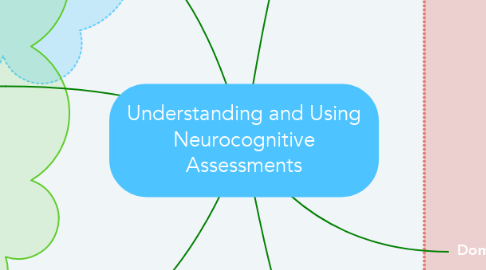Understanding and Using Neurocognitive Assessments
by NICOLE SCHWARZ


1. Appropriate Referral Questions
1.1. Useful assessments driven by appropriate referral questions Diagnostic clarification, child’s level of developmental or cognitive functioning, patterns of strengths and weaknesses, school placement or program eligibility determinations, progress or deterioration over time, forensic issues, suggestions for treatment A good referral request asks a clear, answerable question An understanding of the purpose and limits of psychometric data informs effective use of assessment results Standardized tests can provide normative benchmarks
1.2. strengths and weaknesses
2. Application and what to consider
2.1. Important psychometric factors a neuropsychologist considers include What does it mean for a test to be standardized? What does it mean for a test to be reliable? What does it mean for a test to be valid? Why is it important for a test to be norm-referenced? What is a standardized score (how to interpret a score)? Effective feedback and dissemination of findings Implementation of recommendations Prioritize among recommendations and identify key initial targets for intervention
2.2. School-based recommendations Informal supports and accommodations negotiated with child’s teacher and/or student support team 504 plan to provide formalized accommodations Individualized education program (IEP) to formulate specific and measurable goals Having an outside professional review the services a child is receiving and monitor the child’s progress is helpful for many families Home/outpatient-based services Requires active advocacy skills from parents Have team review recommendations/reevaluate
3. Evaulation:
3.1. Neuropsychological evaluation delinates cognitive strengths and weaknesses and makes specific recommendations regarding classroom placement, accommodations, and special education and therapy needs
4. Purpose:
4.1. Theres no medical treatments for core symptoms for neurodevelopment disabilities
4.2. Medications for some of the disorders that target core symptoms but most effective with using behavioral and cognitive interventions
4.3. Assessments help to determine a child’s functional capacities and needs in real-world settings, such as home and school
5. Domains Function
5.1. Executive function Cognitive abilities that govern behavior regulation and goal-oriented activity Working memory, inhibition, flexibility, monitoring, planning, and generativity Language Ability to understand language, express needs and wants, establish social relationships, make the sounds of speech Motor speech capacities and pragmatic nonverbal communications such as gestures
5.2. Visual processing Perception and spatial location; visual processing closely associated with visual construction skills, perception of visual gestalts, and visual pattern recognition Learning and memory Learning can be impaired for visual or verbal information in the context of core deficits in language or verbal processing A neuropsychological evaluation should provide specific insight into how a child learns best and in which learning conditions the child will require extra support
5.3. General intelligence Considered the benchmark against which other cognitive abilities are measured IQ tests capture only some of the abilities that govern a person’s performance in society: multiple intelligences exist Attention Closely associated with executive functioning Subdomains (orienting, focusing, shifting, and sustaining attention) Affected by such factors as anxiety, arousal, difficulty of the task, motivation, and the novelty and type of situation
6. Models:
6.1. Bernstein’s model of assessment: three key variables 1. Development (understanding typical development and that of specific child being assessed) 2. Brain (understanding brain structure/function, expected in the specific disorder and observed in child being assessed) 3. Context in which the child, with his or her specific brain, is developing
6.1.1. Assessment integrates test performance, behavioral observations, contextual information, principles of development, and knowledge of brain function

